Analysis of the Spatial and Temporal Evolution and Driving Factors of Landscape Ecological Risk in the Four Lakes Basin on the Jianghan Plain, China
Abstract
:1. Introduction
2. Study Area and Materials
2.1. Study Area
2.2. Data Sources and Processing
3. Research Methods
3.1. Landscape Ecological Risk Assessment
3.1.1. Evaluation Cell Selection
3.1.2. Landscape Ecological Risk Evaluation Model
3.2. Spatial Statistical Analysis
3.2.1. Global Spatial Autocorrelation and Local Spatial Autocorrelation
3.2.2. Standard Deviation Ellipse and Center of Distribution
3.3. Driving Factor Analysis
3.3.1. Extraction of Driving Factors
3.3.2. Geographic Detector
4. Results
4.1. Dynamic Changes in Landscape Ecological Risk
4.2. Spatial Analysis of Landscape Ecological Risk
4.2.1. Spatial Autocorrelation Analysis
4.2.2. Spatial Pattern Change Analysis
4.3. Importance Analysis of Driving Factors
4.4. Ecological Analysis of Driving Factors
5. Discussion
5.1. Spatial and Temporal Variation in Landscape Ecological Risk
5.2. Sensitive Analysis of Input Data in the Geographic Detector Model
5.3. Landscape Ecological Risk under Multiple Driving Mechanisms
5.4. Limitations of Study and Future Work
6. Conclusions
- (1)
- From 2000 to 2020, the level of LER in the Four Lakes Basin has shown strong and complex changes. In terms of the spatial distribution characteristics, the results mainly reflect high values in the east and low values in the north. During this time, the percentage of sub-low level decreased by 31.86% and the percentage of high level increased by 12.03%. The variations in the LER with time series showed a shift from low and sub-low to sub-high and high levels.
- (2)
- The global Moran’s I of LER declined from 0.542 to 0.505, indicating a clustered distribution in space with a spatial convergence and a weakening of global agglomeration over time. However, with the influence of human activities, the LER was mainly distributed in the local space with H-H clustering during 2010–2020.
- (3)
- The center of the LER in the Four Lakes Basin shifted to the northwest. The center of sub-high and high level transferred from Jianli City to Qianjiang City. The changes in the parameters for the elliptical standard deviation of the LER showed diverse development trends in the two periods. The first period (2000–2010) manifested a diffusion trend, and the second period (2010–2020) manifested a concentrated development trend to the northwest.
- (4)
- For an individual driving factor, LUI (q2000 = 0.785, q2010 = 0.781, q2020 = 0.646) plays a dominant role for the distribution of LER. The spatially heterogeneous distribution in LER affecting the Four Lakes Basin was caused by the interaction of double-factor enhancement and non-linear enhancement. Human disturbance and other natural factors had significantly different impacts on the spatial differentiation of LER in the Four Lakes Basin. The interactions between LUI and HD (q2000 = 0.885, q2010 = 0.888, q2020 = 0.713) were the leading driving factors of LER affecting the basin.
Supplementary Materials
Author Contributions
Funding
Institutional Review Board Statement
Informed Consent Statement
Data Availability Statement
Conflicts of Interest
References
- Peng, J.; Dang, W.X.; Liu, Y.X.; Zong, M.L.; Hu, X.X. Review on landscape ecological risk assessment. Acta Geogr. Sin. 2015, 70, 664–677. [Google Scholar]
- Lei, K.; Pan, H.Y.; Lin, C.Y. A landscape approach towards ecological restoration and sustainable development of mining areas. Ecol. Eng. 2016, 90, 320–325. [Google Scholar] [CrossRef]
- Piet, G.J.; Knights, A.M.; Jongbloed, R.H.; Tamis, J.E.; de Vries, P.; Robinson, L.A. Ecological risk assessments to guide decision-making: Methodology matters. Environ. Sci. Policy 2017, 68, 1–9. [Google Scholar] [CrossRef]
- Xu, W.X.; Wang, J.M.; Zhang, M.; Li, S.J. Construction of landscape ecological network based on landscape ecological risk assessment in a large-scale opencast coal mine area. J. Clean. Prod. 2021, 286, 125523. [Google Scholar] [CrossRef]
- Levine, S.L.; Giddings, J.; Valenti, T.; Cobb, G.P.; Carley, D.S.; McConnell, L.L. Overcoming Challenges of Incorporating Higher Tier Data in Ecological Risk Assessments and Risk Management of Pesticides in the United States: Findings and Recommendations from the 2017 Workshop on Regulation and Innovation in Agriculture. Integr. Environ. Assess. Manag. 2019, 15, 714–725. [Google Scholar] [CrossRef] [PubMed]
- Lin, Y.Y.; Hu, X.S.; Zheng, X.X.; Hou, X.Y.; Zhang, Z.X.; Zhou, X.N.; Qiu, R.Z.; Lin, J.G. Spatial variations in the relationships between road network and landscape ecological risks in the highest forest coverage region of China. Ecol. Ind. 2019, 96, 392–403. [Google Scholar] [CrossRef]
- Wu, J.G. Landscape sustainability science: Ecosystem services and human well-being in changing landscapes. Landsc. Ecol. 2013, 28, 999–1023. [Google Scholar] [CrossRef]
- Loibl, W.; Smidt, S. Ozone exposure Areas of potential ozone risk for selected tree species in Austria. Environ. Sci. Pollut. Res. 1996, 3, 213–217. [Google Scholar] [CrossRef]
- Landis, G.W. Twenty Years Before and Hence; Ecological Risk Assessment at Multiple Scales with Multiple Stressors and Multiple Endpoints. Hum. Ecol. Risk Assess. Int. J. 2003, 9, 1317–1326. [Google Scholar] [CrossRef]
- Ran, P.L.; Hu, S.G.; Frazier, A.E.; Qu, S.J.; Yu, D.; Tong, L.Y. Exploring changes in landscape ecological risk in the Yangtze River Economic Belt from a spatiotemporal perspective. Ecol. Ind. 2022, 137, 108744. [Google Scholar] [CrossRef]
- Zhang, F.; Ayinuer, Y.S.J.; Wang, D.F. Ecological risk assessment due to land use/cover changes (LUCC) in Jinghe County, Xinjiang, China from 1990 to 2014 based on landscape patterns and spatial statistics. Environ. Earth Sci. 2018, 77, 491. [Google Scholar] [CrossRef]
- Jin, X.; Jin, Y.X.; Mao, X.F. Ecological risk assessment of cities on the Tibetan Plateau based on land use/land cover changes–Case study of Delingha City. Ecol. Ind. 2019, 101, 185–191. [Google Scholar] [CrossRef]
- Chen, J.; Dong, B.; Li, H.R.; Zhang, S.S.; Peng, L.; Fang, L.; Zhang, C.B.; Li, S. Study on landscape ecological risk assessment of Hooded Crane breeding and overwintering habitat. Environ. Res. 2020, 187, 109649. [Google Scholar] [CrossRef] [PubMed]
- Newbold, T.; Hudson, L.N.; Arnell, A.P.; Contu, S.; Palma, A.D.; Ferrier, S.; Hill, S.L.L.; Hoskins, A.J.; Lysenko, I.; Phillips, H.R.P.; et al. Has land use pushed terrestrial biodiversity beyond the planetary boundary? A global assessment. Science 2016, 353, 288–291. [Google Scholar] [CrossRef] [PubMed]
- Bhattachan, A.; Emanuel, R.E.; Ardon, M.; Bernhardt, E.S.; Anderson, S.M.; Stillwagon, M.G.; Ury, E.A.; Bendor, T.K.; Wright, J.P. Evaluating the effects of land-use change and future climate change on vulnerability of coastal landscapes to saltwater intrusion. Elem. Sci. Anth. 2018, 6, 62. [Google Scholar] [CrossRef]
- Zhang, W.; Chang, W.J.; Zhu, Z.C.; Hui, Z. Landscape ecological risk assessment of Chinese coastal cities based on land use change. Appl. Geogr. 2020, 117, 102174. [Google Scholar] [CrossRef]
- O’Neill, R.V.; Krummel, J.R.; Gardner, R.H.; Sugihara, G.; Jackson, B.; DeAngelis, D.L.; Milne, B.T.; Turner, M.G.; Zygmunt, B.; Christensen, S.W.; et al. Indices of landscape pattern. Landsc. Ecol. 1988, 1, 153–162. [Google Scholar] [CrossRef]
- Wang, M.J.; Wu, Y.M.; Wang, Y.; Li, C.; Wu, Y.; Gao, B.P.; Wang, M. Study on the Spatial Heterogeneity of the Impact of Forest Land Change on Landscape Ecological Risk: A Case Study of Erhai Rim Region in China. Forests 2023, 14, 1427. [Google Scholar] [CrossRef]
- Yang, Y.P.; Chen, J.J.; Lan, Y.P.; Zhou, G.Q.; You, H.T.; Han, X.W.; Wang, Y.; Shi, X. Landscape Pattern and Ecological Risk Assessment in Guangxi Based on Land Use Change. Int. J. Environ. Res. Public Health 2022, 19, 1595. [Google Scholar] [CrossRef]
- Wang, L.J.; Luo, G.Y.; Ma, S.; Wang, H.Y.; Jiang, J.; Zhang, J.G. Integrating landscape ecological risk into ecosystem service value assessment: A case study of Nanjing City, China. Ecol. Ind. 2023, 154, 110625. [Google Scholar] [CrossRef]
- Li, X.H.; Ai, Z.; Yang, Z.M.; Yao, Y.Y.; Ren, Z.Y.; Hou, M.J.; Li, J.Y.; Cao, X.S.; Li, P.; Zhang, D.H.; et al. Ecological risk assessment and restoration area identification of Pengyang County on the basis of the landscape pattern and function. Environ. Monit. Assess. 2023, 195, 998. [Google Scholar] [CrossRef]
- Qian, Y.; Dong, Z.; Yan, Y.; Tang, L.N. Ecological risk assessment models for simulating impacts of land use and landscape pattern on ecosystem services. Sci. Total Environ. 2022, 833, 155218. [Google Scholar] [CrossRef] [PubMed]
- Zhou, Z.F.; Zhao, W.Q.; Lv, S.; Huang, D.H.; Zhao, Z.L.; Sun, Y.P. Spatiotemporal Transfer of Source-Sink Landscape Ecological Risk in a Karst Lake Watershed Based on Sub-Watersheds. Land 2023, 12, 1330. [Google Scholar] [CrossRef]
- Wang, W.; Wang, H.F.; Zhou, X.H. Ecological risk assessment of watershed economic zones on the landscape scale: A case study of the Yangtze River Economic Belt in China. Reg. Environ. Chang. 2023, 23, 105. [Google Scholar] [CrossRef]
- Liu, F.L.; Yang, L.; Shu, W. Spatial and Temporal Evolution and Correlation Analysis of Landscape Ecological Risks and Ecosystem Service Values in the Jinsha River Basin. J. Resour. Ecol. 2023, 14, 914–927. [Google Scholar]
- Peng, L.; Dong, B.; Wang, P.; Sheng, S.W.; Sun, L.; Fang, L.; Li, H.R.; Liu, L.P. Research on ecological risk assessment in land use model of Shengjin Lake in Anhui province, China. Environ. Geochem. Health 2019, 41, 2665–2679. [Google Scholar] [CrossRef]
- Cui, L.; Zhao, Y.H.; Liu, J.C.; Han, L.; Ao, Y.; Yin, S. Landscape ecological risk assessment in Qinling Mountain. Geol. J. 2018, 53, 342–351. [Google Scholar] [CrossRef]
- Zhang, H.R.; Zhang, J.N.; Lv, Z.Z.; Yao, L.J.; Zhang, N.; Zhang, Q. Spatio-Temporal Assessment of Landscape Ecological Risk and Associated Drivers: A Case Study of the Yellow River Basin in Inner Mongolia. Land 2023, 12, 1114. [Google Scholar] [CrossRef]
- Qu, M.; Tian, Y.; Liu, B.X.; Xu, D.W. Ecological Risk Assessment and Impact Factor Analysis of Ecological Spatial Patterns in Coastal Counties: Taking Dalian Pulandian District as an Example. Sustainability 2023, 15, 11805. [Google Scholar] [CrossRef]
- Lin, X.; Wang, Z.T. Landscape ecological risk assessment and its driving factors of multi-mountainous city. Ecol. Indi. 2023, 146, 109823. [Google Scholar] [CrossRef]
- Chen, X.M. Sanjiang Plain Wetlands Change and Driving Forces in Recent 60 Years. Master’s Thesis, Jilin Normal University, Jilin, China, 2014. [Google Scholar]
- Liu, J.P.; Ma, C.D.; Liu, Y.; Sheng, L.X. Quantitative study on the driving factors of marsh change based in Geographical Detector—Case study on Small Sanjiang Plain. J. Northeast Norm. Univ. (Nat. Sci. Ed.) 2017, 49, 127–135. [Google Scholar]
- Kang, Y.; Guo, E.L.; Wang, Y.F.; Bao, Y.L.; Bao, Y.H.; Mandula, N. Monitoring Vegetation Change and Its Potential Drivers in Inner Mongolia from 2000 to 2019. Remote Sens. 2021, 13, 3557. [Google Scholar] [CrossRef]
- Wang, J.F.; Li, X.H.; Christakos, G.; Liao, Y.L.; Zhang, T.; Gu, X.; Zheng, X.Y. Geographical Detectors-Based Health Risk Assessment and its Application in the Neural Tube Defects Study of the Heshun Region, China. Int. J. Geogr. Inf. Sci. 2010, 24, 107–127. [Google Scholar] [CrossRef]
- Wang, J.F.; Xu, C.D. Geodetector: Principle and prospective. Acta Geogr. Sin. 2017, 72, 116–134. [Google Scholar]
- Huang, L.Y.; Wang, J.; Chen, X.J. Ecological infrastructure planning of large river basin to promote nature conservation and ecosystem functions. J. Environ. Manag. 2022, 306, 114482. [Google Scholar] [CrossRef]
- Li, M.Y.; Liang, D.; Xia, J.; Song, J.X.; Cheng, D.D.; Wu, J.T.; Cao, Y.L.; Sun, H.T.; Li, Q. Evaluation of water conservation function of Danjiang River Basin in Qinling Mountains, China based on InVEST model. J. Environ. Manag. 2021, 286, 112212. [Google Scholar] [CrossRef]
- Liu, X.; Wang, Z.; Wang, X.L.; Li, Z.; Yang, C.; Li, E.H.; Wei, H. Status of Antibiotic Contamination and Ecological Risks Assessment of Several Typical Chinese Surface-Water Environments. Environ. Sci. 2019, 40, 2094–2100. [Google Scholar]
- Liu, X.; Wang, Z.; Zhang, L.; Fan, W.Y.; Yang, C.; Li, E.H.; Du, Y.; Wang, X.L. Inconsistent seasonal variation of antibiotics between surface water and groundwater in the Jianghan Plain: Risks and linkage to land uses. J. Environ. Sci. 2021, 109, 102–113. [Google Scholar] [CrossRef]
- Rangel-Buitrago, N.; Neal, W.J.; de Jonge, V.N. Risk assessment as tool for coastal erosion management. Ocean Coast. Manag. 2020, 186, 105099. [Google Scholar] [CrossRef]
- Li, W.J.; Wang, Y.; Xie, S.Y.; Sun, R.H.; Cheng, X. Impacts of landscape multifunctionality change on landscape ecological risk in a megacity, China: A case study of Beijing. Ecol. Ind. 2020, 117, 106681. [Google Scholar] [CrossRef]
- Wang, B.B.; Ding, M.J.; Li, S.C.; Liu, L.S.; Ai, J.H. Assessment of landscape ecological risk for a cross-border basin: A case study of the Koshi River Basin, central Himalayas. Ecol. Ind. 2020, 117, 106621. [Google Scholar] [CrossRef]
- Cliff, A.D.; Ord, K. Spatial Autocorrelation: A Review of Existing and New Measures with Applications. Econ. Geogr. 1970, 46, 269–292. [Google Scholar] [CrossRef]
- Anselin, L. Local indicators of spatial association—LISA. Geogr. Anal. 1995, 27, 93–115. [Google Scholar] [CrossRef]
- Zhao, Y.F.; Wu, Q.R.; Wei, P.P.; Zhao, H.; Zhang, X.W.; Pang, C.K. Explore the Mitigation Mechanism of Urban Thermal Environment by Integrating Geographic Detector and Standard Deviation Ellipse (SDE). Remote Sens. 2022, 14, 3411. [Google Scholar] [CrossRef]
- Lin, Y.; Guo, L.N.; Wang, F.L.; Li, S.; Jiang, G.H.; Zhao, Y.X. Research on the temporal and spatial changes of crop planting landscape and fragmentation: Taking Yutian country in Tangshan as an example. Sci. Surv. Mapp. 2021, 46, 83–92. [Google Scholar]
- Zhuang, D.F.; Liu, J.Y. Study on the model of regional differentiation of land use degree in China. J. Nat. Resour. 1997, 12, 105–111. [Google Scholar]
- Chen, P.; Fu, S.F.; Wen, C.X.; Wu, H.Y.; Song, Z.X. Assessment of impact on coastal wetland of Xiamen Bay and response of landscape pattern from human disturbance from 1989 to 2010. J. Appl. Oceanogr. 2014, 33, 167–174. [Google Scholar]
- Wang, J.F.; Hu, Y. Environmental health risk detection with GeogDetector. Environ. Modell. Softw. 2012, 33, 114–115. [Google Scholar] [CrossRef]
- Song, Y.Z.; Wang, J.F.; Ge, Y.; Xu, C.D. An optimal parameters-based geographical detector model enhances geographic characteristics of explanatory variables for spatial heterogeneity analysis: Cases with different types of spatial data. GISci. Remote Sens. 2020, 57, 593–610. [Google Scholar] [CrossRef]
- Ju, H.R.; Niu, C.Y.; Zhang, S.R.; Jiang, W.; Zhang, Z.H.; Zhang, X.L.; Yang, Z.Y.; Cui, Y.R. Spatiotemporal patterns and modifiable areal unit problems of the landscape ecological risk in coastal areas: A case study of the Shandong Peninsula, China. J. Clean. Prod. 2021, 310, 127522. [Google Scholar] [CrossRef]
- Zhang, S.H.; Zhong, Q.L.; Cheng, D.L.; Xu, C.B.; Chang, Y.L.; Lin, Y.Y.; Li, B.Y. Landscape ecological risk projection based on the PLUS model under the localized shared socioeconomic pathways in the Fujian Delta region. Ecol. Ind. 2022, 136, 108642. [Google Scholar] [CrossRef]
- Wei, H.; Xu, L.P.; Li, X.L.; Li, J.W. Landscape Ecological Risk Assessment and its Spatiotemporal Changes of the Boston Lake Basin. Environ. Sci. Technol. 2018, 41, 345–351. [Google Scholar]
- Gong, J.; Zhao, C.X.; Xie, Y.C.; Gao, Y.J. Ecological risk assessment and its management of Bailongjiang watershed, southern Gansu based on landscape pattern. Chin. J. Appl. Ecol. 2014, 25, 2041–2048. [Google Scholar]
- Liu, Q.; Zhang, Z.L.; Deng, L.; Dong, S.K. Landscape ecological risk and driving force analysis in Red river Basin. Acta Ecol. Sin. 2014, 34, 3728–3734. [Google Scholar]
- Yu, B.W.; Cui, B.S.; Zang, Y.G.; Wu, C.S.; Zhao, Z.H.; Wang, Y.X. Long-Term Dynamics of Different Surface Water Body Types and Their Possible Driving Factors in China. Remote Sens. 2021, 13, 1154. [Google Scholar] [CrossRef]
- Zhu, X.F.; Lu, Y.T.; Wu, P.H.; Ma, X.S.; Zhou, L.Z. Spatial-temporal analysis of landscape ecological risk in different seasons during the past 30 years in Lake Shengjin wetland, lower reaches of the Yangtze River. J. Lake Sci. 2020, 32, 813–825. [Google Scholar]
- Liang, T.; Yang, F.; Huang, D.; Luo, Y.; Wu, Y.; Wen, C.H. Land-Use Transformation and Landscape Ecological Risk Assessment in the Three Gorges Reservoir Region Based on the “Production–Living–Ecological Space” Perspective. Land 2022, 11, 1234. [Google Scholar] [CrossRef]
- Gao, Y. Landscape ecological risk assessment and its spatio-temporal variations in Manas River Basin. Geomat. Spat. Inf. Technol. 2021, 44, 86–89. [Google Scholar]
- Yue, Q.F.; Zhao, X.Q.; Li, S.N.; Tan, K.; Pu, J.W.; Wang, Q. Landscape pattern changes and ecological risk in the Padam River Basin under the background of the “Belt and Road” Initiative. World Reg. Stud. 2021, 30, 839–850. [Google Scholar]
- Huang, M.Y.; Zhong, Y.; Feng, S.R.; Zhang, J.H. Spatial-temporal characteristic and driving analysis of landscape ecological vulnerability in water environment protection area of Chaohu Basin since 1970s. J. Lake Sci. 2020, 32, 977–988. [Google Scholar]
- Xu, J.; Kang, J. Comparison of Ecological Risk among Different Urban Patterns Based on System Dynamics Modeling of Urban Development. J. Urban Plan. Dev. 2017, 143, 04016034. [Google Scholar] [CrossRef]
- Wu, T.; Hou, X.Y.; Xu, X.L. Spatio-temporal characteristics of the mainland coastline utilization degree over the last 70 years in China. Ocean Coast. Manag. 2014, 98, 150–157. [Google Scholar] [CrossRef]
- Tang, L.N.; Wang, L.; Li, Q.Y.; Zhao, J.Z. A framework designation for the assessment of urban ecological risks. Int. J. Sustain. Dev. World Ecol. 2018, 25, 387–395. [Google Scholar] [CrossRef]
- Gao, Y.C.; Liu, Z.H.; Li, R.P.; Shi, Z.D. Long-Term Impact of China’s Returning Farmland to Forest Program on Rural Economic Development. Sustainability 2020, 12, 1492. [Google Scholar] [CrossRef]
- Ai, J.W.; Yu, K.Y.; Zeng, Z.; Yang, L.Q.; Liu, Y.F.; Liu, J. Assessing the dynamic landscape ecological risk and its driving forces in an island city based on optimal spatial scales: Haitan Island, China. Ecol. Ind. 2022, 137, 108771. [Google Scholar] [CrossRef]
- Hou, M.J.; Ge, J.; Gao, J.L.; Meng, B.P.; Li, Y.C.; Yin, J.P.; Liu, J.; Feng, Q.S.; Liang, T.G. Ecological Risk Assessment and Impact Factor Analysis of Alpine Wetland Ecosystem Based on LUCC and Boosted Regression Tree on the Zoige Plateau, China. Remote Sens. 2020, 12, 368. [Google Scholar] [CrossRef]
- Cui, B.H.; Zhang, Y.L.; Wang, Z.F.; Gu, C.J.; Liu, L.S.; Wei, B.; Gong, D.Q.; Rai, M.K. Ecological Risk Assessment of Transboundary Region Based on Land-Cover Change: A Case Study of Gandaki River Basin, Himalayas. Land 2022, 11, 638. [Google Scholar] [CrossRef]
- Xu, M.T.; Bao, C. Quantifying the spatiotemporal characteristics of China’s energy efficiency and its driving factors: A Super-RSBM and Geodetector analysis. J. Clean. Prod. 2022, 356, 131867. [Google Scholar] [CrossRef]
- Luo, F.H.; Liu, Y.X.; Peng, J.; Wu, J.S. Assessing urban landscape ecological risk through an adaptive cycle framework. Landsc. Urban Plan. 2018, 180, 125–134. [Google Scholar] [CrossRef]
- Sun, L.H.; Zhou, D.M.; Cen, G.Z.; Ma, J.; Dang, R.; Ni, F.; Zhang, J. Landscape ecological risk assessment and driving factors of the Shule River Basin based on the geographic detector model. Arid Land Geogr. 2021, 44, 1384–1395. [Google Scholar]
- de Souza Soler, L.; Verburg, P.H. Combining remote sensing and household level data for regional scale analysis of land cover change in the Brazilian Amazon. Reg. Environ. Chang. 2010, 10, 371–386. [Google Scholar] [CrossRef]
- Cui, E.Q.; Ren, L.J.; Sun, H.Y. Evaluation of variations and affecting factors of eco-environmental quality during urbanization. Environ. Sci. Pollut. Res. Int. 2015, 22, 3958–3968. [Google Scholar] [CrossRef]
- Han, B.L.; Liu, H.X.; Wang, R.S. Urban ecological security assessment for cities in the Beijing–Tianjin–Hebei metropolitan region based on fuzzy and entropy methods. Ecol. Model. 2015, 318, 217–225. [Google Scholar] [CrossRef]
- Yao, L.; Liu, J.R.; Wang, R.S.; Yin, K.; Han, B.L. A qualitative network model for understanding regional metabolism in the context of Social–Economic–Natural Complex Ecosystem theory. Ecol. Inform. 2015, 26, 29–34. [Google Scholar] [CrossRef]
- Pullanikkatil, D.; Palamuleni, L.G.; Ruhiiga, T.M. Land use/land cover change and implications for ecosystems services in the Likangala River Catchment, Malawi. Phys. Chem. Earth, Parts A/B/C 2016, 93, 96–103. [Google Scholar] [CrossRef]
- Zhu, E.Y.; Deng, J.S.; Zhou, M.M.; Gan, M.Y.; Jiang, R.W.; Wang, K.; Shahtahmassebi, A. Carbon emissions induced by land-use and land-cover change from 1970 to 2010 in Zhejiang, China. Sci. Total Environ. 2019, 646, 930–939. [Google Scholar] [CrossRef] [PubMed]
- Chen, L.; Wei, Q.; Fu, Q.; Feng, D. Spatiotemporal Evolution Analysis of Habitat Quality under High-Speed Urbanization: A Case Study of Urban Core Area of China Lin-Gang Free Trade Zone (2002–2019). Land 2021, 10, 167. [Google Scholar] [CrossRef]
- Li, S.K.; He, W.X.; Wang, L.; Zhang, Z.; Chen, X.Q.; Lei, T.C.; Wang, S.J.; Wang, Z.Z. Optimization of landscape pattern in China Luojiang Xiaoxi basin based on landscape ecological risk assessment. Ecol. Ind. 2023, 146, 109887. [Google Scholar] [CrossRef]
- Wang, H.; Li, C. Analysis of scale effect and change characteristics of ecological landscape pattern in urban waters. Arab. J. Geosci. 2021, 14, 569. [Google Scholar] [CrossRef]
- Fu, G.; Xiao, N.W.; Qiao, M.P.; Qi, Y.; Yan, B.; Liu, G.H.; Gao, X.Q.; Li, J.S. Spatial-temporal changes of landscape fragmentation patterns in Beijing in the last two decades. Acta Ecol. Sin. 2017, 37, 2551–2565. [Google Scholar]
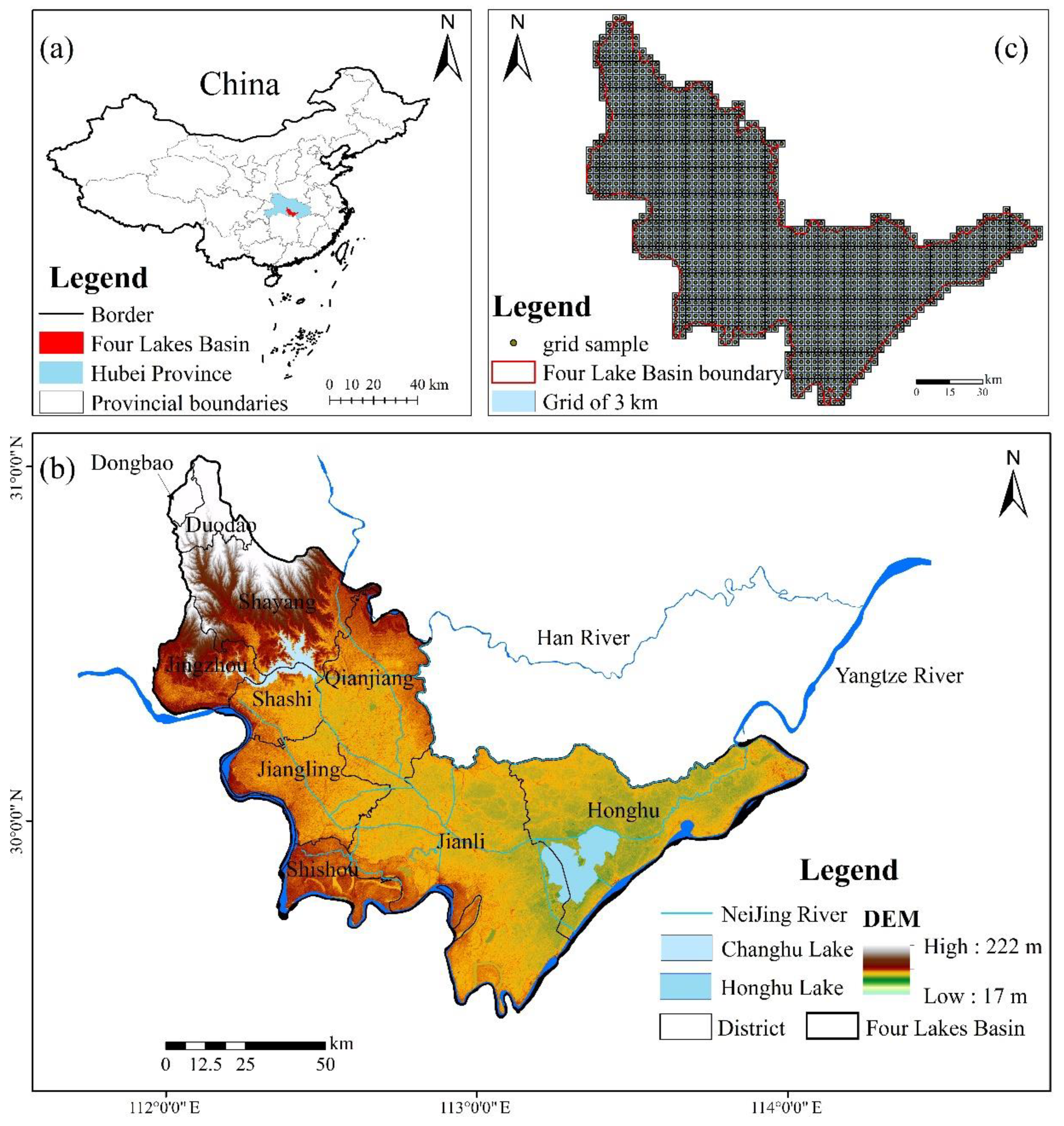
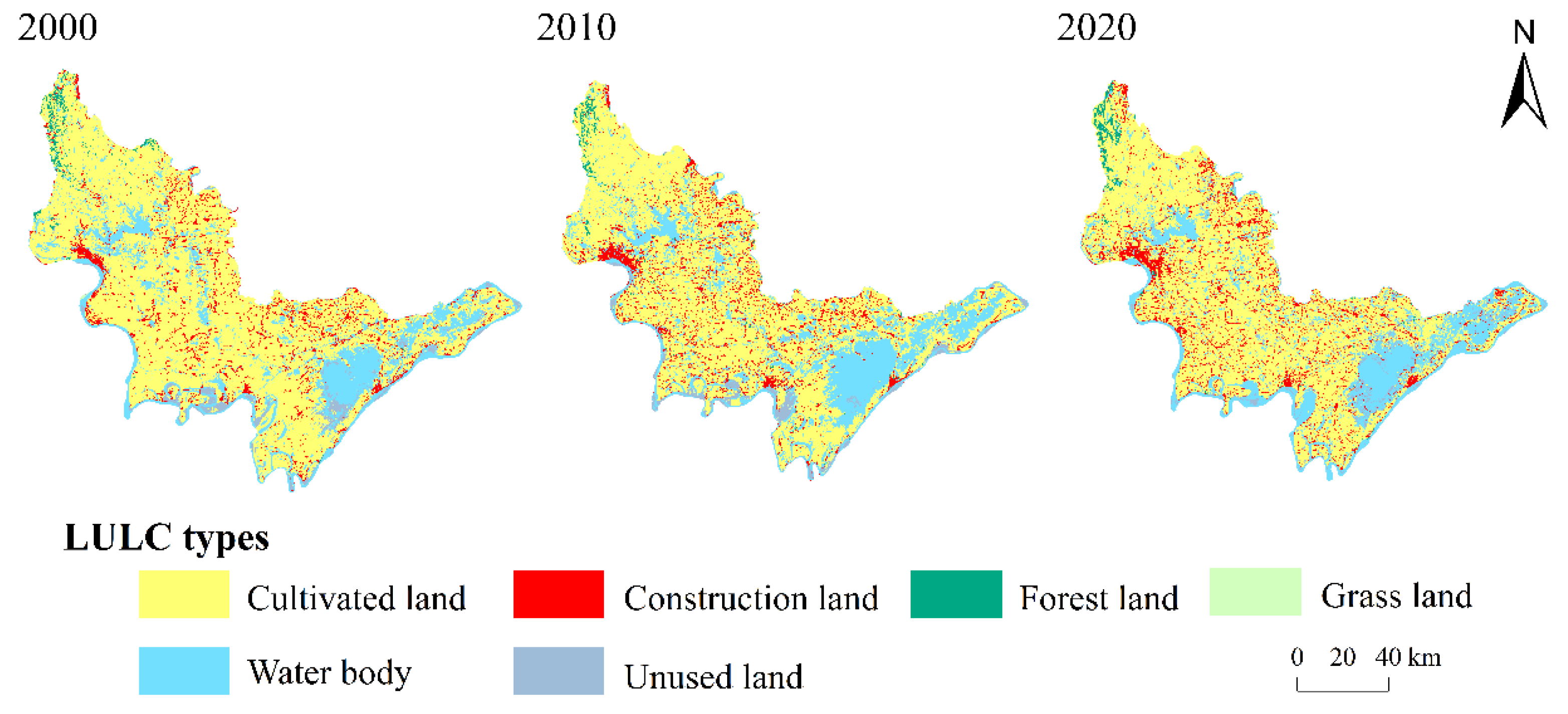

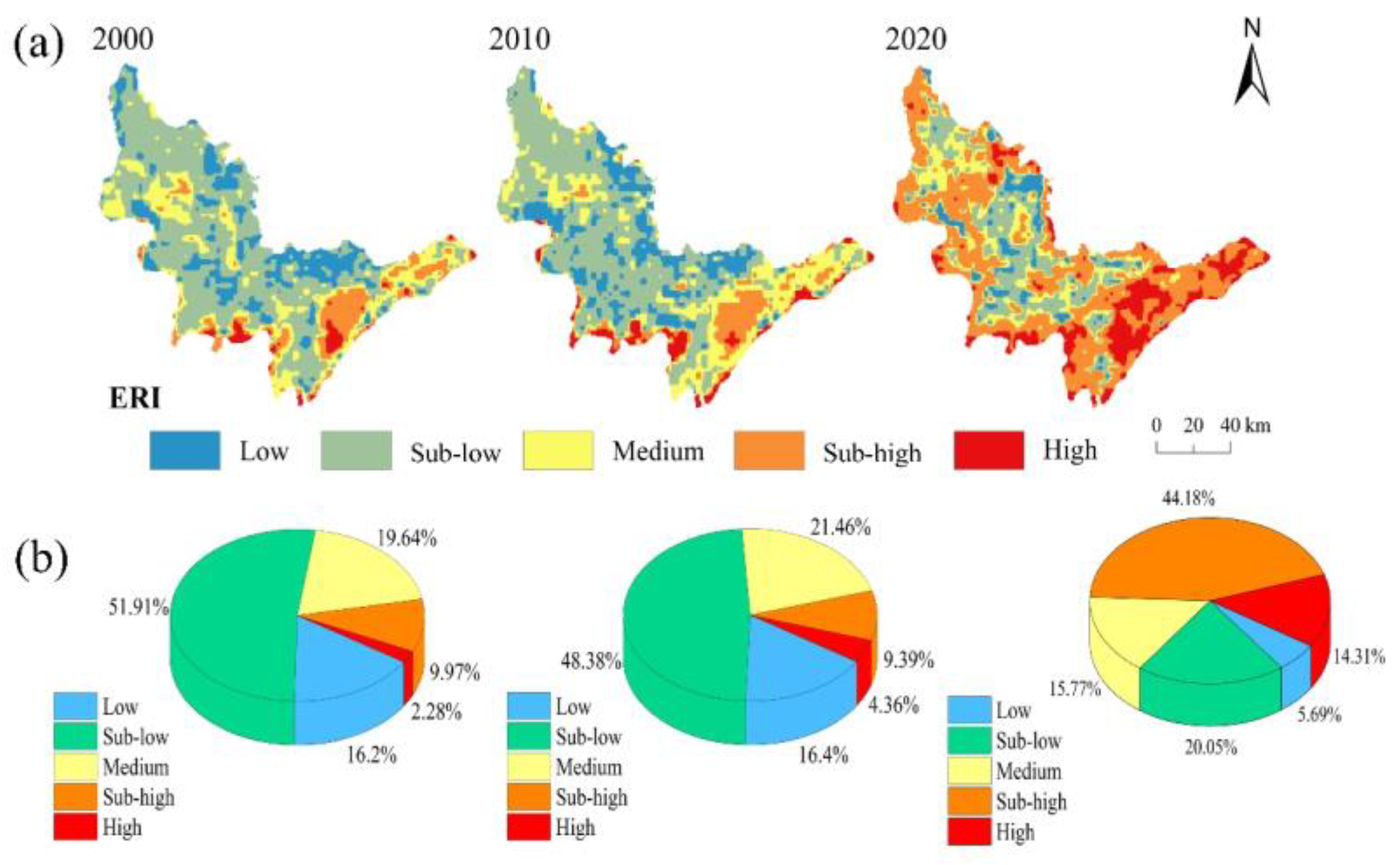
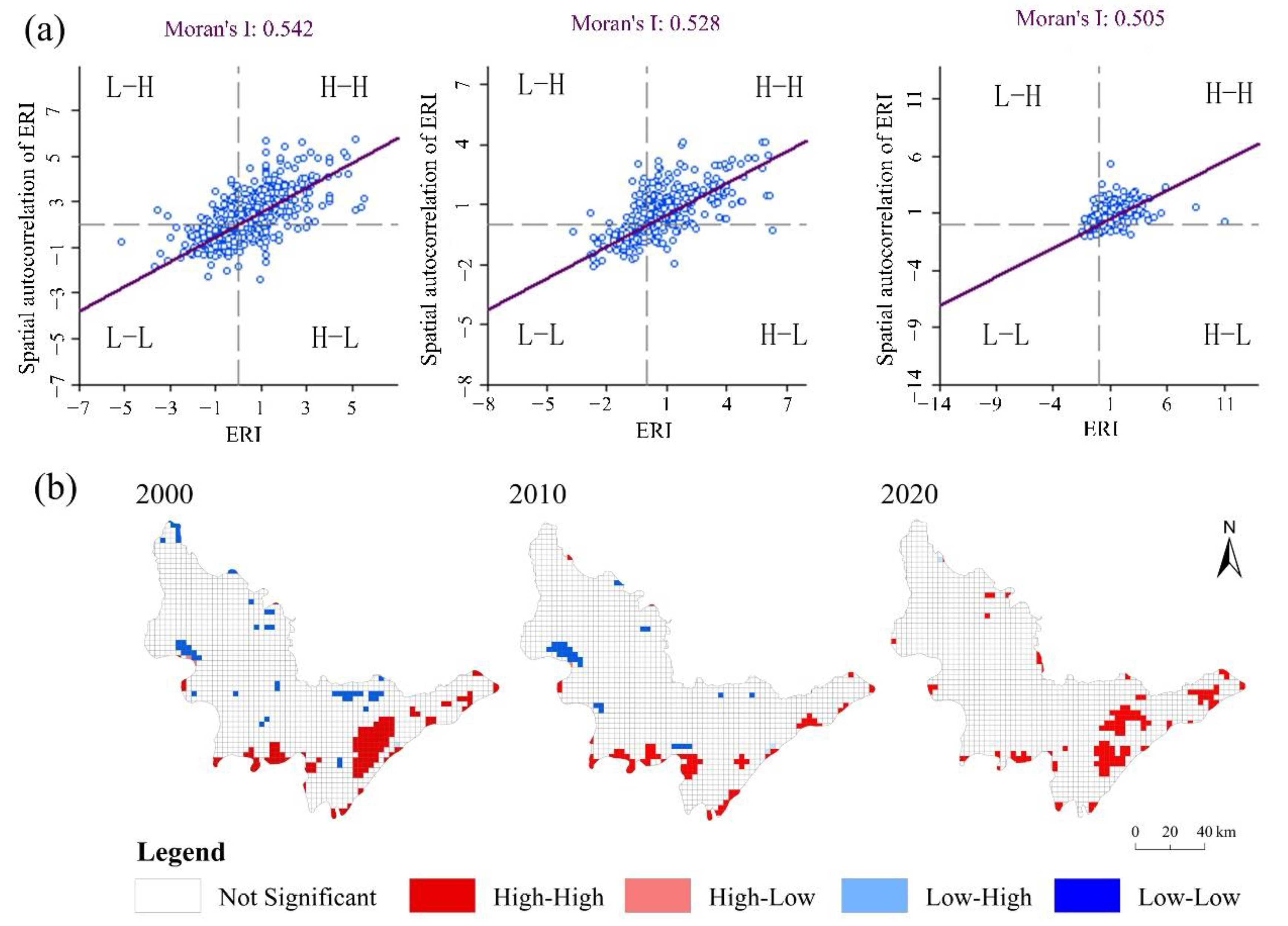
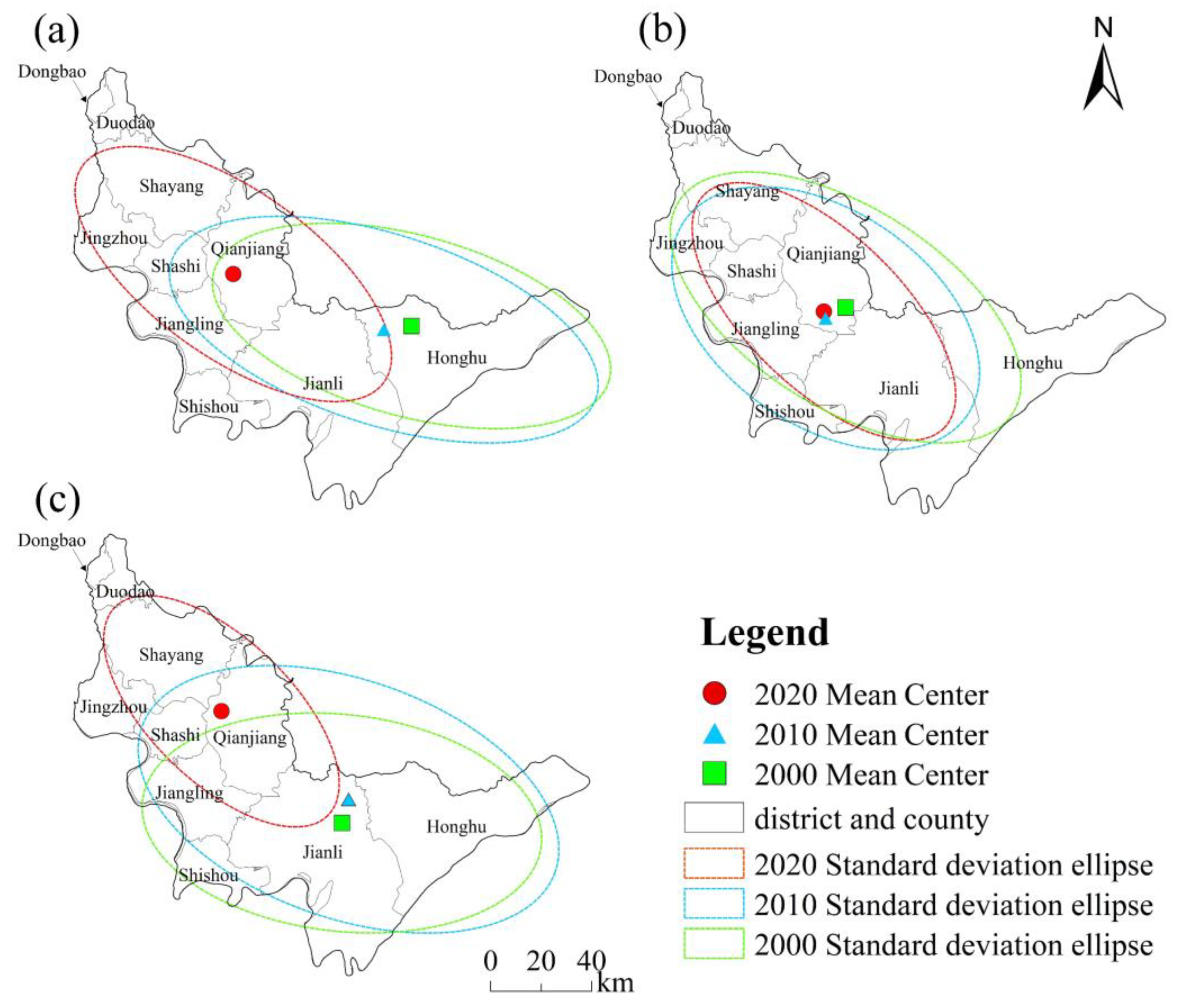
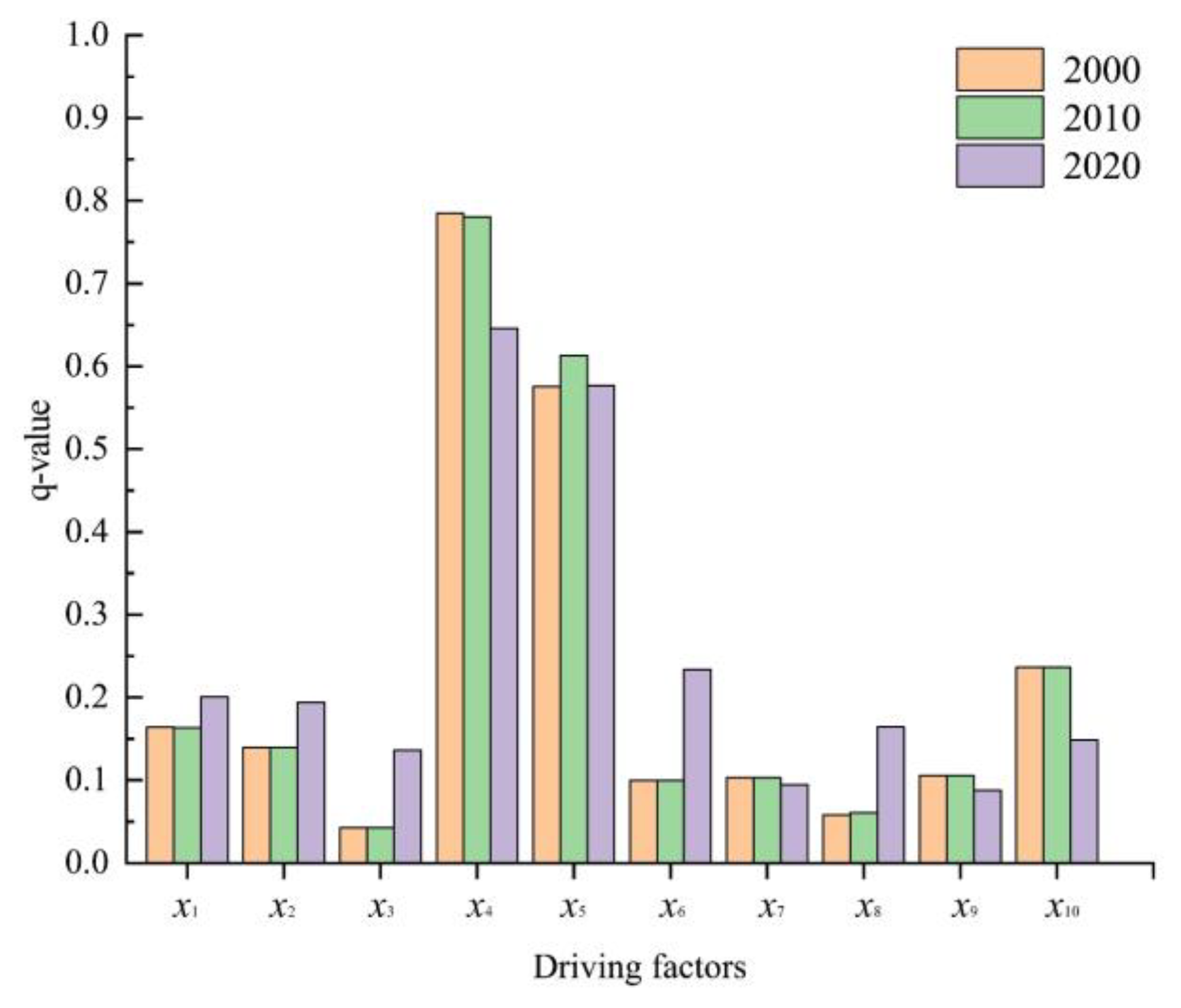

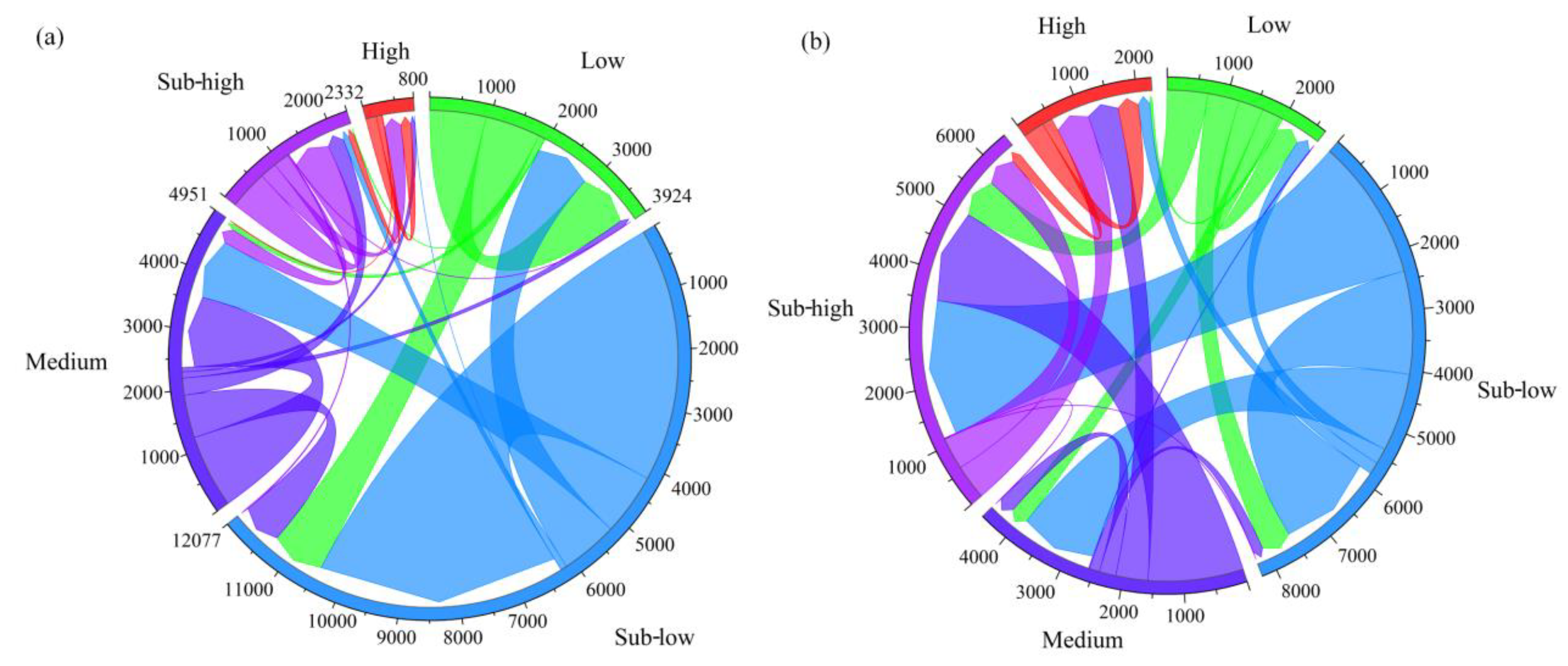


| Data | Time | Resolution | Source |
|---|---|---|---|
| Landsat 5/8 RS images | 2000, 2010, and 2020 | 30 m | http://earthexplorer.usgs.gov/ (accessed on 11 May 2022) |
| DEM | - | 30 m | https://www.gscloud.cn/ (accessed on 11 May 2022) |
| Rainfall and temperature | 2000, 2010, and 2020 | - | https://data.cma.cn/ (accessed on 11 May 2022) |
| MODIS-NDVI | 2000, 2010, and 2020 | 250 m | https://modis.gsfc.nasa.gov/ (accessed on 12 May 2022) |
| Population density | 2000, 2010, and 2020 | 1000 m | http://www.worldpop.org/ (accessed on 13 May 2022) |
| Description | Interaction |
|---|---|
| q(X1 ∩ X2) < Min[q(X1), q(X2)] | Weakened, non-linear |
| Min[q(X1), q(X2)] < q(X1 ∩ X2) < Max[q(X1), q(X1)] | Weakened, single factor non-linear |
| q(X1 ∩ X2) > Max[q(X1), q(X2)] | Enhanced, double factors |
| q(X1 ∩ X2) = q(X1) + q(X2) | Independent |
| q(X1 ∩ X2) > q(X1) + q(X2) | Enhanced, non-linear |
| ERI Level | Year | Longitude | Latitude | Long Half-Axle/km | Short Half-Axle/km | Elliptic Area/km2 |
|---|---|---|---|---|---|---|
| Sub-low and low | 2000 | 113.35 | 30.09 | 81.24 | 35.85 | 9147.24 |
| 2010 | 113.24 | 30.08 | 88.41 | 37.73 | 10,478.09 | |
| 2020 | 112.62 | 30.28 | 73.55 | 32.93 | 7607.22 | |
| Medium | 2000 | 112.77 | 30.18 | 78.37 | 39.63 | 9756.64 |
| 2010 | 112.69 | 30.14 | 68.03 | 42.56 | 9095.53 | |
| 2020 | 112.68 | 30.16 | 66.34 | 30.61 | 6377.59 | |
| Sub-high and high | 2000 | 113.07 | 29.98 | 79.5 | 42.95 | 10,726.71 |
| 2010 | 113.1 | 30.07 | 86.77 | 47.23 | 12,875.41 | |
| 2020 | 112.58 | 30.39 | 59.01 | 28.23 | 5232.24 |
| Year | 2000 | 2010 | 2020 | |
|---|---|---|---|---|
| Index | ||||
| NP | 11,762 | 13,661 | 17,676 | |
| PD | 0.9762 | 1.1338 | 1.467 | |
| COHESION | 99.7077 | 99.6875 | 99.3485 | |
| SPLIT | 23.0178 | 23.2429 | 60.8445 | |
| SHDI | 1.6387 | 1.6866 | 1.7736 | |
Disclaimer/Publisher’s Note: The statements, opinions and data contained in all publications are solely those of the individual author(s) and contributor(s) and not of MDPI and/or the editor(s). MDPI and/or the editor(s) disclaim responsibility for any injury to people or property resulting from any ideas, methods, instructions or products referred to in the content. |
© 2023 by the authors. Licensee MDPI, Basel, Switzerland. This article is an open access article distributed under the terms and conditions of the Creative Commons Attribution (CC BY) license (https://creativecommons.org/licenses/by/4.0/).
Share and Cite
Xia, Y.; Li, J.; Li, E.; Liu, J. Analysis of the Spatial and Temporal Evolution and Driving Factors of Landscape Ecological Risk in the Four Lakes Basin on the Jianghan Plain, China. Sustainability 2023, 15, 13806. https://doi.org/10.3390/su151813806
Xia Y, Li J, Li E, Liu J. Analysis of the Spatial and Temporal Evolution and Driving Factors of Landscape Ecological Risk in the Four Lakes Basin on the Jianghan Plain, China. Sustainability. 2023; 15(18):13806. https://doi.org/10.3390/su151813806
Chicago/Turabian StyleXia, Ying, Jia Li, Enhua Li, and Jiajia Liu. 2023. "Analysis of the Spatial and Temporal Evolution and Driving Factors of Landscape Ecological Risk in the Four Lakes Basin on the Jianghan Plain, China" Sustainability 15, no. 18: 13806. https://doi.org/10.3390/su151813806
APA StyleXia, Y., Li, J., Li, E., & Liu, J. (2023). Analysis of the Spatial and Temporal Evolution and Driving Factors of Landscape Ecological Risk in the Four Lakes Basin on the Jianghan Plain, China. Sustainability, 15(18), 13806. https://doi.org/10.3390/su151813806





